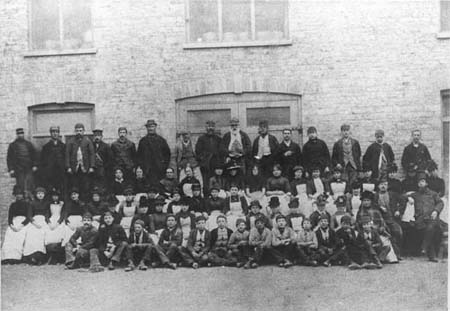

Child labourCloth making had been carried out in people's homes for centuries before the introduction of the factory system. Working at home, the man of the house would operate the loom while his wife and children kept him supplied with yarn by processing the raw wool. Girls and young women were often employed at home as spinners, working at a spinning wheel for many hours every day turning the carded wool into yarn. Children were very often given the task of 'quilling' which involved winding the spun wool onto bobbins; these were then fitted into shuttles ready to start weaving the yarn into cloth. This is how William Smith, founder of Smith's blanket company, started his working life before he was ten years old. Children could be apprenticed to master weavers at quite a young age, sometimes under 10 years. In 1793 the Witney Blanket Weavers' Company (the local trade guild) ruled that the minimum age for becoming an apprentice should be 13 years old. The apprentice signed an agreement called an 'indenture' which bound them to work for the same employer, usually for seven years. In signing it they agreed to serve their master faithfully, keep his secrets and not to haunt alehouses and inns or play at cards! In return the master had to teach the apprentice the trade, and supply him with food, drink, lodging and washing facilities for the term of the apprenticeship [1]. When blanket factories came on the scene in the early 19th century some children were sent to work in them, as there were no laws governing the age of workers or the hours that they worked. From the factory owners' point of view children were cheap to employ, as well as being small and nimble; they could do jobs that adults would struggle to do, such as cleaning debris from under moving machinery and tying broken threads on the machines. The work was often dangerous, repetitive and tiring and many factory owners kept the machines running for as many hours as they could.  Group of Witney mill workers, late 19th century. The front row appears to be made up of quite young boys and there are some slightly older girls sat behind them. In Witney in the early 19th century Richard Early opened his factory from 4.00am to 8.00pm and required constant attendance every day in the week from 6.00am to 6.00pm with two hours for meal breaks [2]. Men, women and children were responsible for feeding the machines and keeping them running smoothly, as any stoppage meant a loss in profits. A person's working life could often be much longer than it is today and people would carry on doing their job into their eighties and nineties if they lived that long!
|
|
| References [1] Plummer 1934: p48 [2] Clements unpub.: p18 |
|
